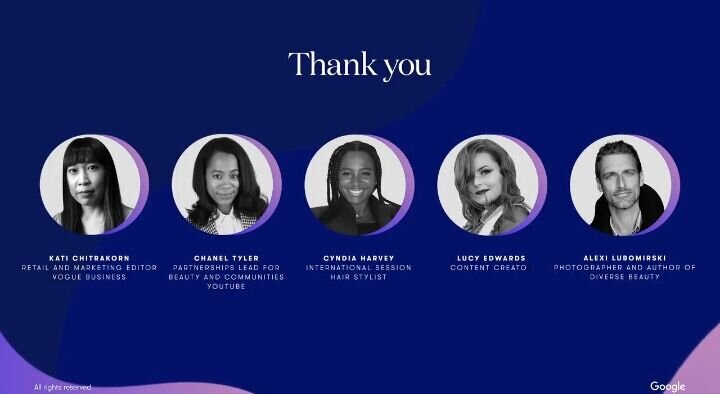Takeaways from The Vogue Business ‘The Way Forward’ Summit
The innovation lab specialises in sharing in-depth analyses of key areas that would typically fall under the sector of marketing. These are an accumulation of insights and emerging industry-specific trends summarised to suit the interests of our readers, with the intention to encourage innovation within the digital space. It will cover everything new and next that is bound to affect consumer interests and behaviour across fashion, retail, beauty, wellness, luxury, food and drink, media and youth. These are written from the lens of our Founder, Prisca Moyesa.
Vogue Business, the go-to fashion industry publication, invited me to their ‘The Way Forward’ 2021 virtual summit. The summit set out to explore what is new and next for fashion. And in Vogue’s own words, “fashion, beauty and luxury companies are rethinking strategies, investing in technologies and pushing ahead on sustainability plans, while figuring out how their customer has changed, and how to meet them now.” Passionate about how challenger brands can harness these shifts and reach a tech-positive generation, I sat in several sessions to ensure I was welcoming a new legion of marketing, in a way that would keep us up to speed with the latest trends and ensure that clients of ours would be a part of this shift. In this article I summarise key sessions but the majority of what you’ll read today are my thoughts.
Key Areas of Focus
Across both days, editors from Vogue Business were matched with a dynamic group of well-renowned luxury brands, such as: Tory Burch, Burberry, Bathing Ape, Browns and Tommy Hilfiger. They held space for fashion and beauty tech businesses: Fartetch, The Realreal, Mytheresa and Nordstrom, introduced viewers to the minds behind Google, YouTube and Roblox, and shined a light on the forward-thinking platforms that are working to support industry innovation within the UK, US, EU and China. These were: Xiaohongshu, L Catterton and Lukso.
Both days unpacked discussions from expert panellists touching upon:
🎤: Marketing to the Luxury Consumer
🎤: Beauty and Inclusivity
🎤: Fashion Resale
🎤: The Metaverse
🎤: Manufacturing
🎤: The Gen Z Retailer
🎤: Technology and Innovation
What is the metaverse?
If I had 100 likes for every person that asked us to define the metaverse, what it means for the future of marketing, what NFTs are, then we would go viral. At Moyesa & Co. we pride ourselves in our ability to transpose technical terms into simplified well-defined sentences that clear the debris from a new concept and shine a light on only the most relevant parts. To us, the Metaverse is the virtual world mimicking human touchpoints. Another great definition comes from Chief Metaverse Officer at the Futures Intelligence Group, Cathy Hackl that I too believe we can all get behind. She states that the Metaverse is “your digital lifestyle catching up to your physical lifestyle.”
If the definition’s mentioned still perplexes you, this extract from the session should provide you with more clarity.
via Vogue Business
Por ejemplo¿
The intention of the metaverse is to communicate using the digital realm and as a means to build bonds. A familiar example of this is the technology used in gaming. An example of a metaworld would be The Sims.
A further example of a metaverse platform is Roblox, as its gameplay mechanics become a place for Gen Z (in particularly) to socialise and connect. This references back to Hackl’s point about the digital world converging with physical facets now developing into a fully-fledged metacommerce experience. For both Roblox and The Sims, fashion is used as a means to define a digital reality, identity and embodiment of values. This is also true for Minecraft, commonly used by Gen Z gamers across YouTube like our very own gaming influencer, 5H0RTIE.
At the summit, the context for the metaverse was within the remit of fashion. Commonly, fashion’s role in innovation has been slow although it is an industry known to be centred around fantasy, creativity and self-expression. The closing message was whether luxury brands, in particular, should have a Metaverse strategy. What are your thoughts?
The Future of Luxury Investments
A much-required session that took place was on the future of luxury investments. When I launched Moyesa & Co. it was with the intention to support challenger brands and startups, whether they’re VC-backed fintech companies like our client BlackCurve or independent fashion brands like CANG. Our intention is to help develop these brands using social media and content in a bid to raise their valuation. So to sit in a discussion that explored how brands can garner the attention of customers and investors, was in alignment with the work we do and eye-opening. Here are a few things that can be beneficial to direct-to-consumer brands and business-to-business companies.
Buying Behaviour
In an effort to help drum up sustainability, and with the support of social commerce, consumers are buying less but buying better. We cannot deny that “fast” fashion has its perks, and works for low-income households, especially for loungewear and trips to local supermarkets, but it also has its cons. Conscious consumerism has always been how we aim to approach strategy work. There are a plethora of ways to sell to someone in a way that fits within their lifestyle, and aligning with consumer interests is an effective marketing strategy, which reinforces the notion to spend more money, access better quality products and sustain items for longer. But if this is the case, how will challenger brands be able to sell and scale?
Scale, Beyond Profit
There’s no doubt that today’s brands will be here in 20 years, it’s whether they will still have the awareness and attention of their target groups. A consumer-centric approach is a smart one, how can you lose? But this only occurs when brands go beyond self-serving metrics and get to the soul of why their product or service is a convenient option for their target group. Yes, it’s hard to visualise when we factor in the need for a return-on-investment, but follow in Fenty Beauty’s footsteps; align with a cultural context, use acquisition channels like Twitter and Instagram to ramp up community participation and you’ll find yourself at over $100 million in revenue. It’s marketing science.
Last month we shared an informative post by Ritika, which highlighted how startups can raise their valuation without putting sales at the forefront of every strategic move. This aligns perfectly with the panellists’ points that scaling beyond profit will be the most ideal business model for companies moving forward.
Acquisition
The key to being acquired is in the VC book of Google and If I were to dig into it, you will miss your next Zoom call. But I will share this, for fashion brands, investors are looking to see what new elements brands they’re interested in can bring to the table, because cash is no longer the issue. Are they tapping into a greener way of manufacturing? Do you have the ability to attract, retain and develop talent? How are you going beyond a good product? Companies need to think about acquiring competencies that can win the new generation of consumers.
Beauty and Inclusivity
If you are new to Moyesa & Co.’s blog, you may not know how important inclusion is to us. Cultural diversity has been neglected for years but there is no innovation without an out-of-the-box and fresh mind. This panel took my understanding and empathy to a whole other level.
What stood out to me what the discussion on how products are made and shelved, and how they often lack inclusivity and consideration for the blind customer, for example.
The reason we are a marketing studio and not merely social media or content is because we consider different touchpoints of the customer’s journey. Our strategy arm explores how to better serve the needs of the end consumer, and if pulling those insights from the internet or our focus groups needs to be done beyond the need to post a picture on Stories, then we are all-encompassing and accommodating.
Here are some of the key quotes from the session:
“Brands focus too much on the metrics and not empathy.”
“We need to see diversity within #brand and #campaign meetings.”
“There’s so much learning that needs to happen, instead of doing things that are performative.”
“Newer brands have a bigger advantage in building #diversity, exclusivity, equity and transparency.”
“It can't be performative, it’s got to come from the heart.”
“We all have these encyclopedia’s in our pocket. We can't stay in ignorance anymore”.
Understanding China’s Gen Z customers
It is in Generation Z’s nature to align with technology and make the most of all that it has to offer. They have a hunger for innovation and aren’t afraid to create it if and when it is not offered to them. Of course, these insights heavily speak to Gen Z customers in the UK, US and China, but we cannot deny how this generation has accelerated change.
The panel explored the “habits, behaviours, interests and lifestyles” of Generation Z and very quickly the group of panellists identified how Gen Z has a major influence on online aesthetics, curating a visual language informed by the internet. Here are some of the key takeaways.
Jiangxiaobai x Mengniu’s “adult ice cream shop” via Jing Daily
Value-based Resonance
It is no surprise that one of the key statements were that the Chinese subgroup is different from the western subgroups. This automatically shifts their buying behaviour, albeit that they are the generation who are accustomed to luxury brands and lifestyles. This familiarity requires brands to work harder to wow this cohort, as they are not afraid to switch their attention. Transformative branding, knowing the story you want to tell and being authentic about your brand’s value is what this cohort desire. Balenciaga’s in-game partnerships with Fornite was mentioned, another ode to gaming and the purchase of fashion items as digital versions within the virtual space. A smart way for luxury brands to keep their inventory and legacy alive.
Source: Epic Games
Physical Shopping and Spending Habits
A lot of attention is on Generation Z, there’s no denying they are at the forefront of the industry. Physical experience still appeals to this group and a future that solely depends on digital is not what they desire. However, digital fulfilment helps to minimise waste and support carbon neutrality. Suggestions were that brands need not put all their eggs into the Gen Z basket but be mindful about their spending habits as their earning power grows and as they shift into an older age bucket.










